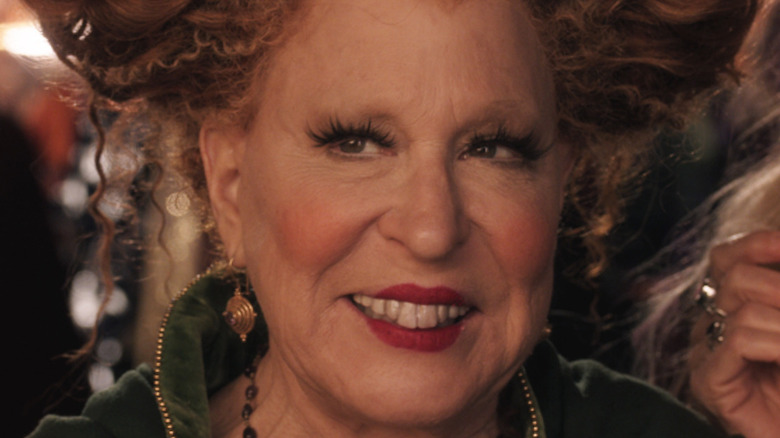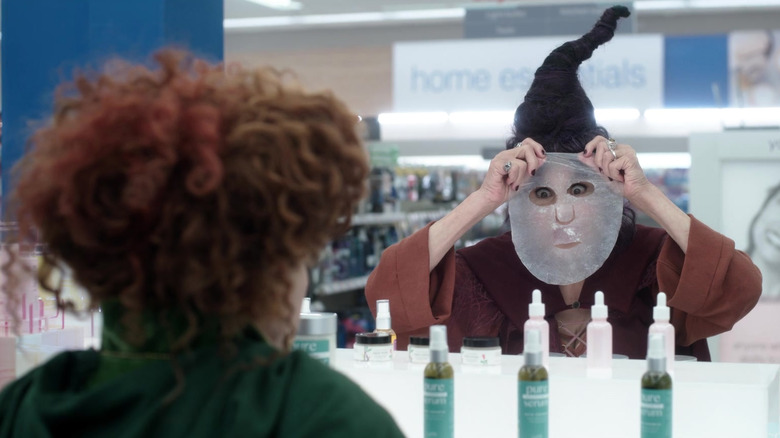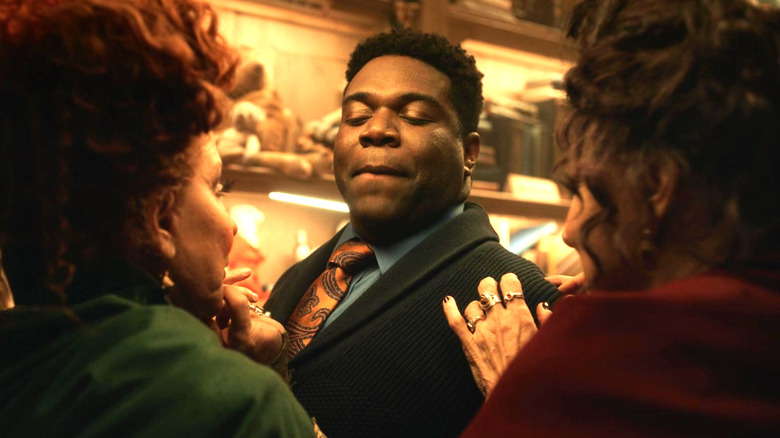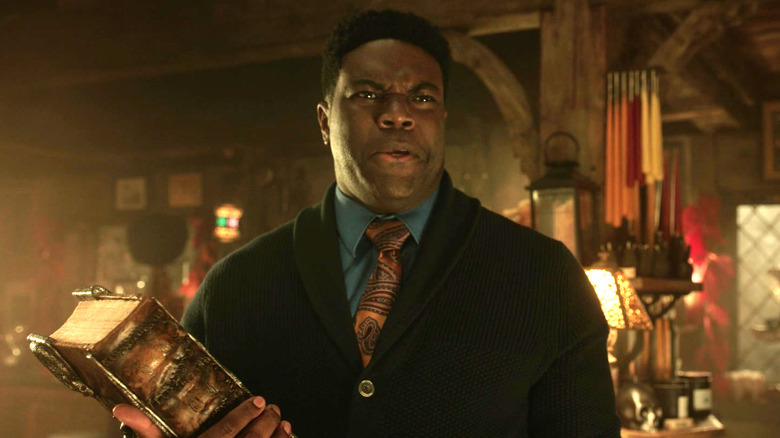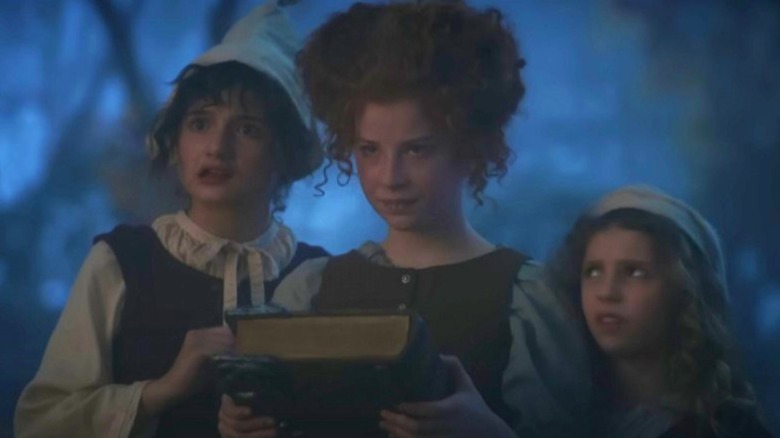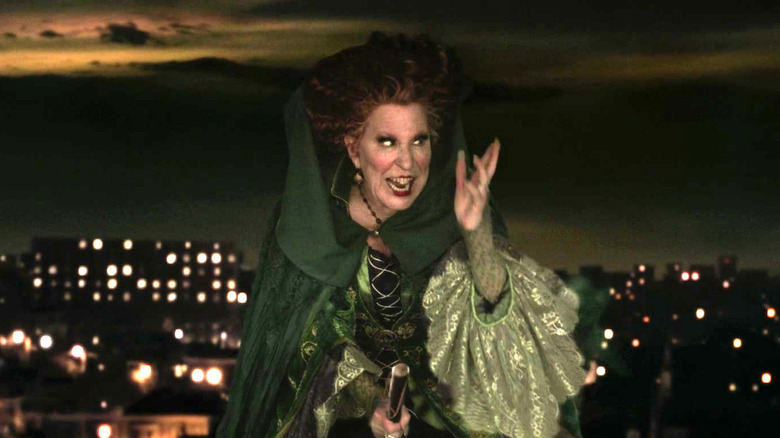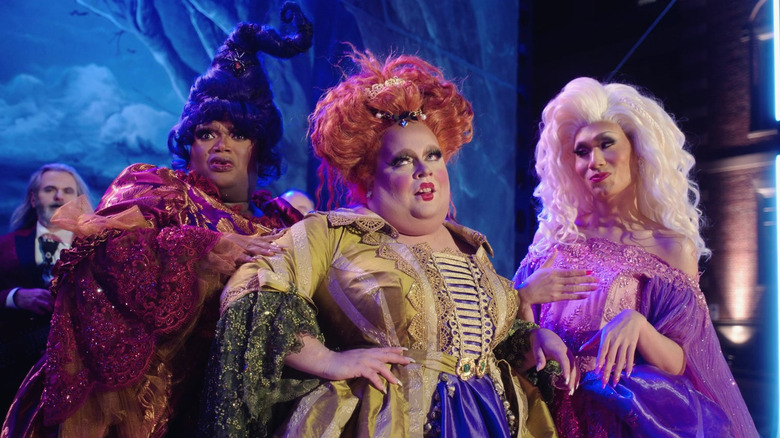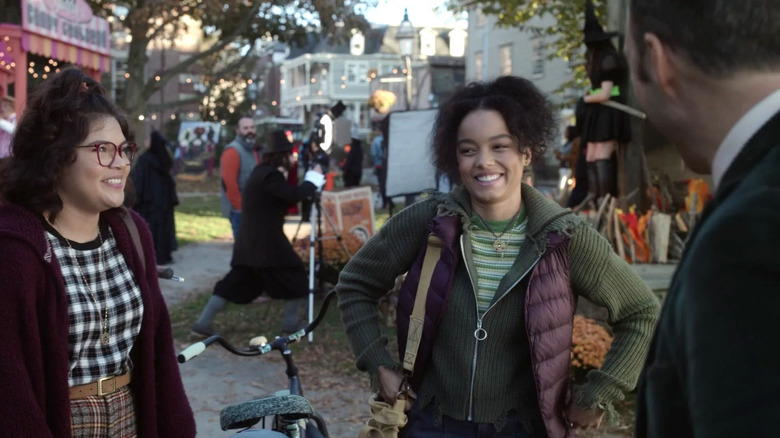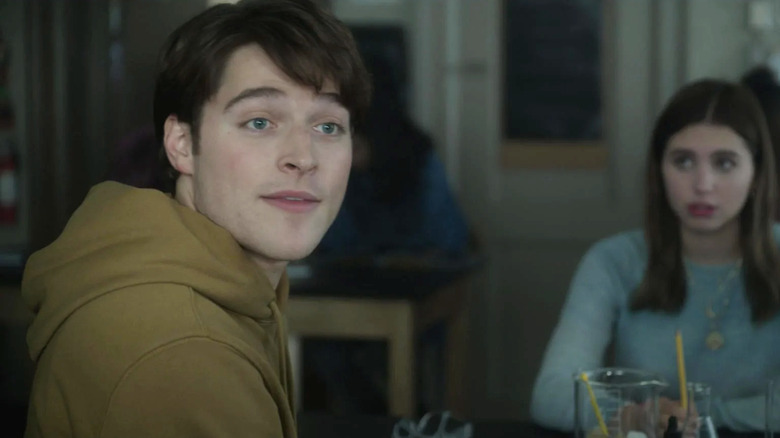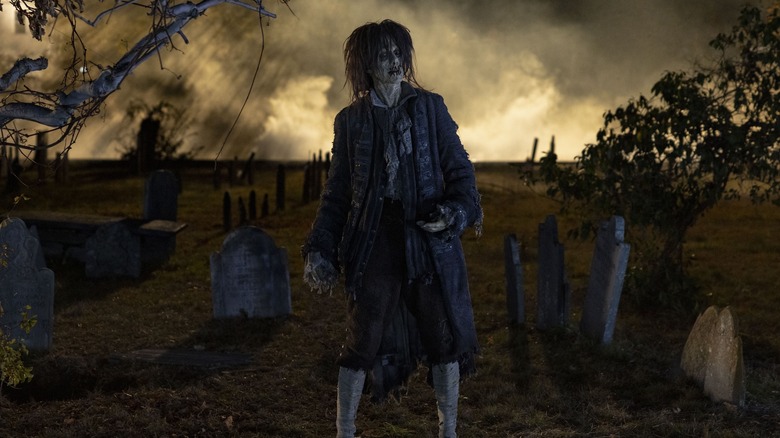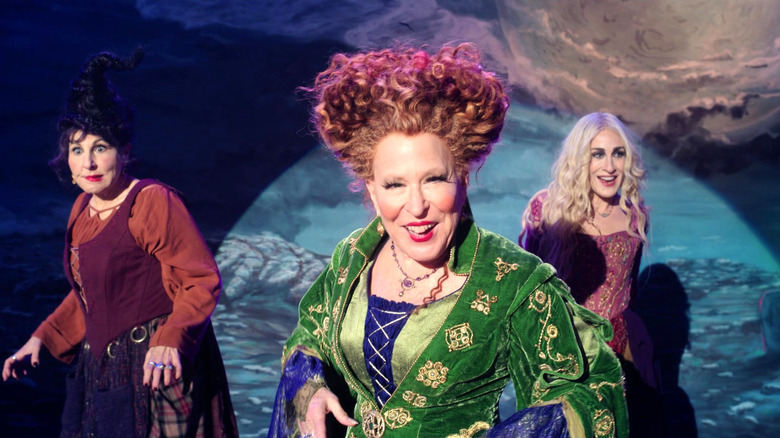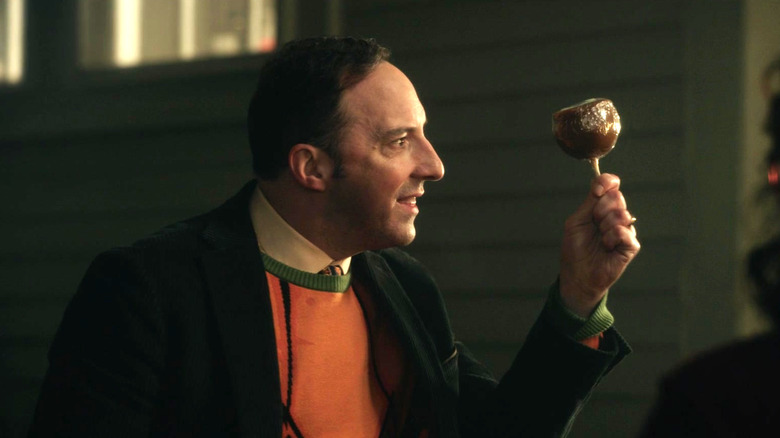Things Only Adults Notice In Hocus Pocus 2
In 2022, 29 years after they came back from the dead the first time, sisters Winifred (Bette Midler), Sarah (Sarah Jessica Parker), and Mary Sanderson (Kathy Najimy) returned from oblivion to terrorize the town of Salem, Massachusetts for another Halloween adventure in "Hocus Pocus 2." This time, however, everyone's favorite coven isn't just interested in making it through the night; they're intent on becoming all-powerful and borderline immortal with the help of an extremely dangerous spell that will cost Winifred everything she holds dear.
Like its predecessor, "Hocus Pocus 2" is all-ages entertainment that parents, kids, and grandparents can watch together without getting too lost in the plot or alienated by the characters. It crosses the generational gap by telling a story that keeps moving and addressing the needs of its audience through jokes directed squarely at every age group. However, there are certain elements that will probably go over the heads of younger viewers.
We'll be discussing all the jokes, plot details, and behind-the-scenes technical stuff that younger viewers aren't aware of (or just don't care about), and that older audiences might appreciate/question a bit more. Here are the things that only adults notice in "Hocus Pocus 2."
Warning: this post contains spoilers for "Hocus Pocus 2."
The face of a child?
The Sandersons can stay young and escape mortality by consuming the souls of children. The opening of the original "Hocus Pocus" shows the sisters brewing a potion that they then feed to a child, which allows them to sip on their soul until it has been devoured. The entire plot of that movie hinges on them trying to brew another batch of the stuff in order to avoid dying once the sun rises. In "Hocus Pocus 2," this dark concept is taken to a whole new height.
As soon as the Sanderson sisters return, they try to figure out a way to consume the souls of the two teenagers who unwittingly brought them back. The girls Becca (Whitney Peak) and Izzy (Belissa Escobar) trick them into thinking that they are 40-years-old and that the souls of children have now been bottled up and are being sold at Walgreens.
The sisters visit the modern apothecary and immediately begin drinking and eating various creams, sprays, and lotions to try to devour the "children" inside. At one point, Mary opens a face mask and jokes about it being a child's face before tearing into it with her teeth. The visual is obviously meant to be a gag, but the implication is a little troubling: Do the Sandersons actually eat children's flesh and not just their souls?
A Veep reunion
While it is unfortunate that original "Hocus Pocus" cast members Omri Katz, Vinessa Shaw, and Thora Birch did not return for "Hocus Pocus 2," the new cast fits into the world exceptionally well and holds their own. Two newcomers to Salem are Sam Richardson, appearing as Gilbert the Magic Shoppe owner and massive fan of the Sanderson sisters, and Tony Hale, who pulls double duties as both Reverend Traske in the 17th century and his present-day descendent Mayor Traske.
Although most kids will probably find them delightfully goofy in the film, some parents will also get a kick out of the fact that both actors appeared alongside Kathy Najimy on the HBO series "Veep."
The foul-mouthed political satire about the Vice President of the United States garnered a lot of critical acclaim, but chances are none of those reviews came from kids considering the very adult dialogue and dull (to a child) subject matter.
In "Veep," Hale plays Gary Walsh, the little bird constantly in Selina's ear, who feeds her necessary information when she needs it. Najimy plays Wendy, the wife of political aide Mike McLintock, while Richardson plays Richard, a friendly but somewhat bumbling aide to Selina.
Gilbert's not a virgin
It's established in the original "Hocus Pocus" that the only way to bring back the Sandersons is for a virgin to light the black flame candle. In "Hocus Pocus 2," Gilbert explains that there can be multiple candles, which is how the Sandersons return yet again — Gilbert made another candle. Not only that, but the ending of the film shows that he made more than one.
Every year since they were five, Becca, Izzy, and Cassie have gone to the forbidden wood and perform a ritual for Becca's birthday. This is such a common occurrence that practically everyone they come across in the film mentions it. One of those people is Gilbert, who gives them a special candle that he made himself, which is imbued with a little extra magic for Becca's special occasion. In fact, it is secretly a black flame candle. Since the girls are virgins, the witches return when Becca and Izzy light it.
They confront Gilbert, asking why he didn't just light it himself. He tells them that it wouldn't have worked, which first elicits confusion from the girls, then understanding, then a bit of disgust. This scene plays out mostly in facial expressions, so it's likely that kids may not get what's being referenced here, but it's certainly not lost on older siblings and parents, who might get a laugh from it.
16 and married
"Hocus Pocus 2" opens with a prologue set in 1653, when Salem was just a small village and Winifred Sanderson was just turning 16. We get a little insight into how the witches began their careers as Salem's terrorizers. They flee to the forbidden woods and meet the Witch Mother (Hannah Waddingham), who reveals Winifred's power to her and provides her with the living magic spell book we all know and love.
While there isn't anything in this opening that's inappropriate for younger audiences, there is a detail some (if not all) of them might find shocking: Winifred is expected to get married at the age of 16. She informs her sisters that she's all hopped up on rage because Reverand Traske has informed her that she is now of a marrying age, despite being so young compared to our modern standards.
Although it may be shocking to imagine that someone so young would be forced to marry, some adults might recall that the life expectancy of humans in the 1600s was not what it is today (via Age Up). Considering people were expected to live just 40 years or so, folks got married and started reproducing a lot sooner than today. So, in this instance, the thing adults might notice is that this was a very real standard for the time.
Production values
For anyone who remembers seeing "Hocus Pocus" for the first time back in the early '90s, one of its shining achievements is the way it captures the perfect fall and Halloween atmosphere, thanks largely to the fact that much of it was actually filmed in the real Salem, Massachusetts. That spirit comes through particularly when Max heads home from school, walking by trees that blaze with autumnal color and a real cemetery with all the quiet, serene spookiness that comes with it.
Sadly, this touch of realism doesn't appear in "Hocus Pocus 2," which was filmed instead in Providence, Rhode Island. Although Rhode Island can be beautifully eerie in its own way, the fact that it's a different location means that something feels alien and unfamiliar about the setting on a subconscious level, at least for big fans of the original movie.
Besides that, there are scenes that appear cheap and out of place when compared to "Hocus Pocus." The best example of this is the scene when the sisters fly through the night in front of a skyline that almost looks like a painting rather than a rear-screen projection, green screen, or virtual set of LED screens. Hopefully, most kids get too caught up in the adventure to notice the poor backgrounds and odd, cavernous quality of some of the street scenes, but some nit-picky adults probably noticed.
Greater diversity
As wonderful as the original "Hocus Pocus" is, there isn't much in the way of cast diversity. One could argue that this is an honest depiction of Salem's general population at the time, but in a film about undead witches who eat the souls of children to stay alive (that also features a talking cat and a zombie), real-world accuracy isn't exactly a storytelling concern. Instead, it's more likely that this was a result of the hiring practices in the '90s.
The diversity of "Hocus Pocus 2" is obvious from the start when we see that two of the main characters are not white. The movie also makes an effort of including a more diverse group of Salem citizens as the story progresses. Although none of this is pointed out, we see people from different walks of life all over, such as the drag queens participating in the costume contest.
What's great about this is that it's treated as just a part of life. The movie never stops the action to point out how progressive it is — it simply allows these characters to be themselves and instead focuses on the story it's telling and the ways they're involved in it. Kids may not notice this because they're used to it by now, but for adults who remember what it was like when almost everyone on screen was part of the same demographic, it's a welcome (and overdue) change.
A macabre photo op
Early on in "Hocus Pocus 2," Becca and Izzy walk through town on their way to the Magic Shoppe to get items for their annual ritual. They have to pass through the main square where the Halloween festival is being set up. Vendors are getting things ready and townspeople are walking around in costume in anticipation of the night's festivities.
At this moment, Becca and Izzy encounter Mayor Traske, who is super excited to tell them about the candy apple vendor coming up from Boston. It's a funny scene that allows Tony Hale to be as goofy as possible, while also establishing that he has a strong history with these girls, since his daughter Cassie used to be one of their best friends. Oddly enough though, there is a bizarre photo shoot happening in the background.
A photographer in colonial garb takes shots of a young woman in a skimpy witch outfit posing on top of a phony fire. It's a blink-and-you-miss-it moment and for the kids who do catch it, they might think nothing of it. After all, snapping a photo at every opportunity is part of the world they're growing up in now. But adults who understand the history of the Salem witch trials and the fact that young women lost their lives due to prejudice (by all sorts of means, including fire) might see this as dark and inappropriate subject matter for a picture.
A slightly younger tone
"Hocus Pocus 2" is a movie that the whole family can enjoy, just like the original. However, grownup fans of that first movie might notice that some of the edges have been sanded off, making for a viewing experience that leans slightly more towards the younger side of things than the first film did. For example, most of the characters in the sequel behave like cartoons, rather than real people.
Perhaps the worst offender is Mike (Froy Gutierrez), who picks up the baton of dumb, childish bully from the original's Ice and Jay. The difference here is that Jay and Ice at least appear to pose a threat to Max and his little sister. Mike, on the other hand, is just a clueless buffoon who doesn't even know he's a bully. Removing that sense of danger (false as it may be) makes everything feel a bit safer.
The same goes for Mayor Traske, who is delightful, but a little too over-the-top to feel like a real dad who actually cares about his daughter. Even the Sandersons (pretending to eat a baby face aside) seem much tamer and more inviting this time around. Yes, their goal is horrific, but their attitudes and performances are dialed up a bit more than when we last saw them. Plus, the film places way less emphasis on sexuality and innuendo, which makes it a bit less exciting for adult viewers.
A disturbing plot convenience
One of the returning characters from the first "Hocus Pocus" is the apple of Winifred's eye, Billie Butcherson (played once again by the always delightful Doug Jones). As exciting as it is to see him back, there's one detail about his inclusion that doesn't quite sit right with more discerning viewers.
The reason he's back is that the Sandersons need the head of a lover in order to properly cast the spell that will turn them into the most powerful coven of all time. They task Gilbert with getting everything they need while they search for Traske. The first place he stops is the local cemetery to dig up Butcherson while commiserating that digging up a grave is going to take all night.
To his shock, Billie isn't buried a full six feet underground (it's more like two) and he's not dead either. Billie explains that the reason he's still alive is that no one put him back to sleep after he was woken up 29 years ago. While that's a nice workaround to keep the plot moving, the images it conjures up are truly disturbing: Billie has just been laying in a coffin for almost 30 years, completely conscious. As life in Salem has gone on, he has been there day and night, completely trapped and unable to do anything. When you really think about it, that's terrifying.
One Way Or Another
In "Hocus Pocus," Winifred and her sisters sing a magical version of the Screamin' Jay Hawkins classic "I Put a Spell on You" to control all the adults in Salem. Considering the song came out long after they were dead, it doesn't make a whole lot of sense that Winifred would be familiar with it. That being said, the subject matter of the song combined with the fact that she's a witch (and, you know, Bette Midler) works so perfectly that you don't really question it.
The scene is so memorable that they had to do another one in the sequel. Rather than using "I Put a Spell on You" again, "Hocus Pocus 2" opts Blondie's "One Way or Another" instead. Within the context of the film, it works: Winifred casts a spell on the people of Salem to hunt for Mayor Traske to ensure that she will find him. Although Blondie lead singer Debbie Harry told Entertainment Weekly the disturbing tidbit that "One Way or Another" was inspired by her getting stalked, the song itself is not very spooky and feels like a strange choice here.
"Hocus Pocus 2" doesn't do anything that creative with the song, whereas the original revamped "I Put a Spell on You," as composer Marc Shaiman rearranged the song to fit Midler's theatrical style (via Bustle). While Screamin' Jay Hawkins' version is a slow song that builds to a scream, "Hocus Pocus" repurposes it as a big Broadway showstopper. "One Way or Another," however, is already a fun song with a great hook and driving melody, so it feels more like a cover than an unexpected incantation.
Poor Mayor Traske
It's easy to see why the Sandersons hate Reverand Traske so much. He is a sanctimonious megalomaniac who wants to tear them apart and turn them into the pure, good people he believes belongs in Salem. Therefore, it makes perfect sense that they hold a grudge against him and are enraged to discover that his descendent also holds a position of power in the town they call home.
The difference between the Mayor and the Reverend though is that the Mayor seems like a genuinely nice, caring guy. He doesn't do anything mean or lord his title over anyone; he just wants everyone to have a good time. We see that he might be a bit strict with his daughter Cassie, but not to a villainous extent. She has a bunch of kids over to his house for a party without permission, and he rushes home to stop it, which is a pretty reasonable reaction.
However, the film treats him like an antagonist. All the poor guy wants is a candy apple and the plot denies him that, as if he were paying for some misdeed. Kids might get a chuckle out of the joke about him having to settle for a crummy candy apple once the vendor runs out. But for adults, this comes off as cruel and unusual punishment.
